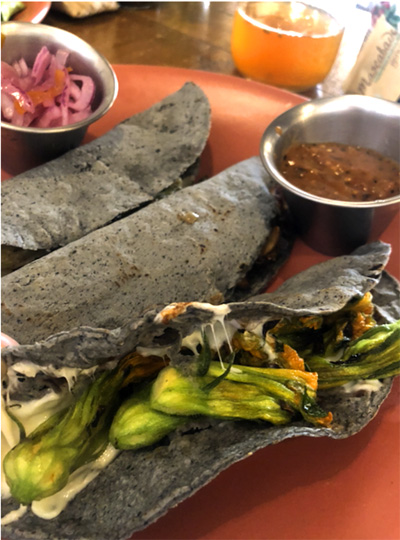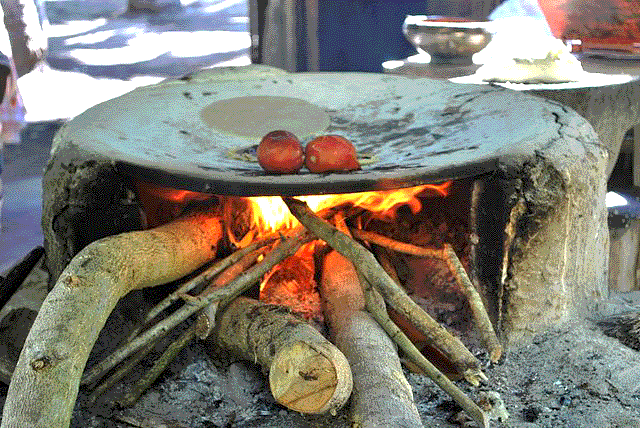


Most fair-size mercados have a comedor area -- a zone designated for small eating establishments. Like the kitchen in an old-time home, the comedor area often serves as a mercado's "heart." Here people can momentarily find a place to sit (often a challenge in a crowded market!), withdraw from the mercado's confusion, exchange gossip, and eat familiar kinds of food much more cheaply prepared than can be found in restaurants along the streets. The picture shows a typical mercado snack -- a quesadilla with a metate of hotsauce placed next to it.
Here some sentences to help you during your own first comedor experiences:
The word comedor is based on the Spanish verb comer, to eat. Thus a comedor is simply an eatery. Nothing fancy, not much selection, and often you are lucky if you get a fork or spoon. In many places you are expected to scoop or grasp your food with a tortilla.
A typical basic comedor consists of one woman (hardly ever a man) with a gas burner or two, a skillet, a pot of some sort of simmering caldo (stew), a pot of beans, a pot of coffee, a basket filled with tortillas bought earlier from the tortillaría (tortilla-making place), and maybe some soda-drinks. If you ask for scrambled eggs, the señora will probably step outside for a moment to buy the eggs, chili, and tomatoes. Comedores often distinguish themselves from their neighbors by the sort of stew they have simmering. A simple sign or chalk board may announce the day's stew.
Especially in comedores of small town mercados in Indian territory, always be on the lookout for dishes that may be local specialties. For example, I wonder if it's possible to find the dish called pepeto anywhere other than Tonatico, México State? Pepeto is concocted from pig knee-joints, tender corn, the green squash called chilacayote, green lima beans, peas, and the herb epazote. Typically it's available only on Sundays and days of festival.
Also be alert for special dishes that may be offered only when the ingredients are in season. For example, along the southern Pacific coast, when sweet corn is in season, look for the stew called elopozole, based on sweet corn, small tender squash, and the herb epazote.
Comedores provide seats where you can sit and eat at the counter or bar. A shade less elaborate than the comedor is the mobile or semimobile "stand," as in "taco stand." Instead of occupying a rented room or stall in or near the mercado -- the case with comedores -- the stand often consists of a sort of bar-on-wheels. The bar may be equipped with a grill or hot plate for preparing hot food on the spot, or it may have a hood covering already-prepared items such as sandwiches. Most stands offer nowhere to sit; at a stand, you stand...
 Other
than food vendors circulating with a single kind of prepared item in a cloth-covered
basket or bucket, the most humble eating establishments in and around mercados consist of
a single person with a portable grill or comal (hot plate), typically fired by
charcoal, on which a single kind of food item is prepared -- maybe elotes (roasted
corn-on-the-cob), quesadillas, or tacos. The one shown at the right is a
classic example; it was sketched near the mercado in Toluca. Comales typically
stand about knee-high, and garnishes such as red and green hot-sauces, mayonnaise, and
shredded cheese fill jars and tin cans perched on nearby crates, or maybe on the sidewalk
itself. People operating these easily movable sidewalk establishments sometimes return to
the same spot day after day for years, offering the same fare, and building up sizable
clienteles.
Other
than food vendors circulating with a single kind of prepared item in a cloth-covered
basket or bucket, the most humble eating establishments in and around mercados consist of
a single person with a portable grill or comal (hot plate), typically fired by
charcoal, on which a single kind of food item is prepared -- maybe elotes (roasted
corn-on-the-cob), quesadillas, or tacos. The one shown at the right is a
classic example; it was sketched near the mercado in Toluca. Comales typically
stand about knee-high, and garnishes such as red and green hot-sauces, mayonnaise, and
shredded cheese fill jars and tin cans perched on nearby crates, or maybe on the sidewalk
itself. People operating these easily movable sidewalk establishments sometimes return to
the same spot day after day for years, offering the same fare, and building up sizable
clienteles.
Every combination of the above mercado-eating strategies is possible. Sometimes mobile stands are equipped with comedor-like stools; some one-comal vendors offer several items instead of just one; occasionally comedores offer such a variety of meals that they almost feel like restaurants.